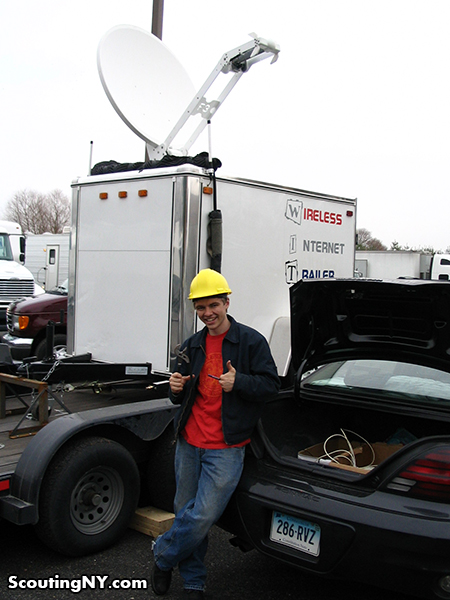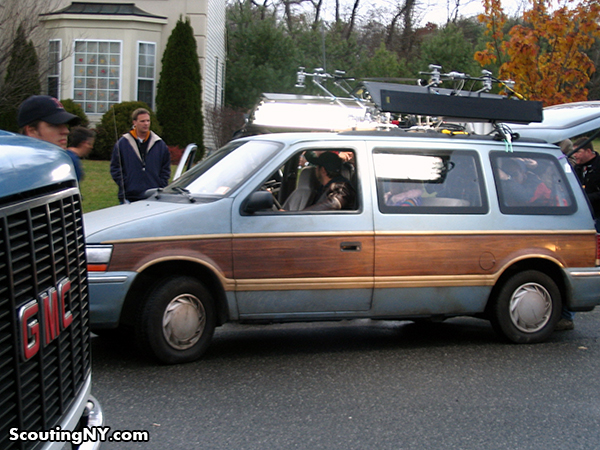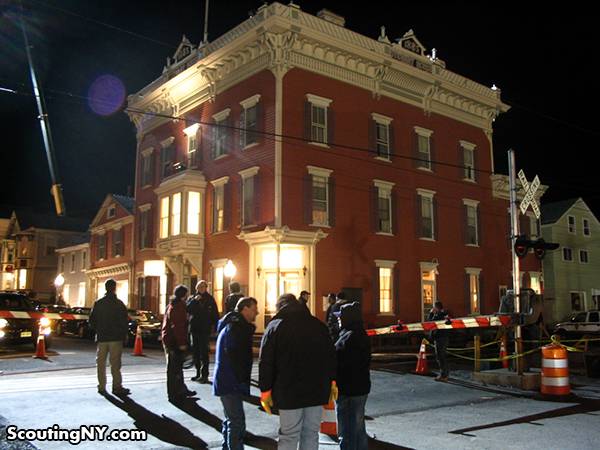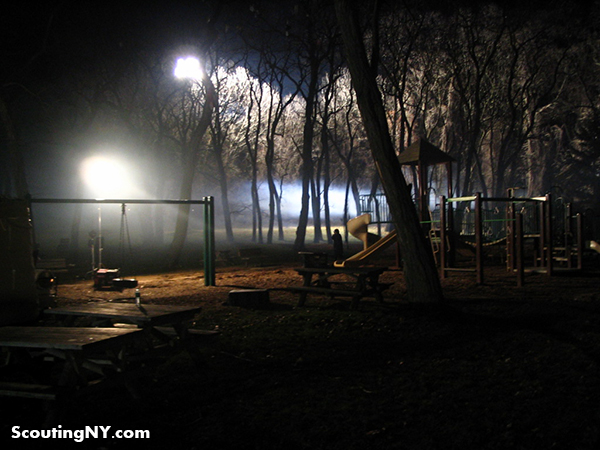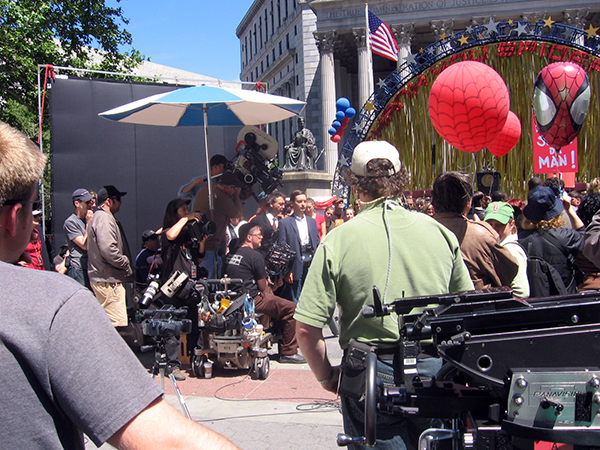Pages
▼
Sunday, 31 January 2016
Hong Kong Harbour
Take a look at Hong Kong from Victoria Harbour. Mack the Knife provides a surprisingly appropriate soundtrack.
Saturday, 30 January 2016
Musical - Martin Scorsese - A Personal Journey Through American Movies
This is Part 6 of Martin Scorsese's Personal Journey Through American Movies.
Movie clips included in this video are as follows:
Gold Diggers of 1935 (1935) - Busby Berkeley
Gold Diggers of 1933 (1933) - Mervyn LeRoy
42nd Street (1933) - Lloyd Bacon
Footlight Parade (1933) - Lloyd Bacon - Starring James Cagney
Meet Me in St. Louis (1944) - Vincente Minnelli
My Dream is Yours (1949) - Michael Curtiz - Inspired Scorcese's New York, New York (1977)
The Bandwagon (1953) - Vincente Minnelli
A Star is Born (1954) - George Cukor
All that Jazz (1979) - Bob Fosse
Movie clips included in this video are as follows:
Gold Diggers of 1935 (1935) - Busby Berkeley
Gold Diggers of 1933 (1933) - Mervyn LeRoy
42nd Street (1933) - Lloyd Bacon
Footlight Parade (1933) - Lloyd Bacon - Starring James Cagney
Meet Me in St. Louis (1944) - Vincente Minnelli
My Dream is Yours (1949) - Michael Curtiz - Inspired Scorcese's New York, New York (1977)
The Bandwagon (1953) - Vincente Minnelli
A Star is Born (1954) - George Cukor
All that Jazz (1979) - Bob Fosse
Friday, 29 January 2016
The Jazz Foundation of America
Now, if only we could have something like this for struggling filmmakers...
Thursday, 28 January 2016
Paris, In Movies
Here's a three minute collection of shots of Paris taken from movies. It was put together by 19 year old French woman Candice Drouet.
Wednesday, 27 January 2016
Ten Tips for independent filmmakers
Gary Hustwit is a successful documentary filmmaker. Last week Filmmaker magazine ran an article by Nick Dawson, called "Gary Huswit's 10 Web Tips for Doc Filmmakers." The article is drawn from a workshop run by Hustwit at the 2012 Documentary Lab, which is an initiative of the Independent Filmmaker Project in New York. And although the focus is on documentary filmmaking, many of the principles can be applied to any independent filmmaking project.
1. Connect with the audience early
With his most recent film, Urbanized, Hustwit launched a website for the movie after he been working on the film for a year, meaning he had a lot of work already under his belt and a clear sense of where the project was going.
Know the shape and plot of the film, and have stuff to show people. But don’t give away all the info immediately. Allow the conversation about the film to evolve over time, and keep people engaged.
2. Crowdsource your info
Three of the urban design projects featured in Urbanized came to his attention via Twitter. Hustwit reaches out to his 150,00 Twitter followers to solicit suggestions for venues in certain cities or towns that he doesn’t know or has not been to recently.
Lots of the aspects of filmmaking—from ideas, production and release —were facilitated through Twitter. Make people feel part of the process, because they are.
3. Stay in regular contact
Aside from tweeting, blog a couple of times a week and send out a newsletter every one or two months when you’re still in production, and once every two weeks when your film is actually screening. When teasing your film during production, put up pictures but not footage.
The fantasy of what your film’s going to be about is often better than the reality.
4. Use your movie to fund your movie
Think creatively about how you can use people’s interest in your movie to help you complete it. With Urbanized, when the film was in the late stages of postproduction Hustwit sold tickets to an exclusive advance screening of the film, and used the money to fund the movie’s color correction.
You want to do your own screenings as you’re going to see revenue from it.
5. Give the people what they want
Whether it’s promotional items (T-shirts, hats, buttons, etc.) during production, or DVDs once the film is completed, supporters of your film want something they can get their hands on. Hustwit made a considerable amount of money through sales of Urbanized merchandise prior to release, and every day sells multiple copies of the $225 institutional DVDs of his films (which can legally be screened to large groups at universities and schools).
6. Be you, not your film
When going from one film to another, you should aim to take the audience with you. Use social media and the web as the tool to do it. Hustwit has a personal Twitter account rather than a Twitter account for each film, and has continued to grow a following for himself.
Talk as you would to a friend, another member of the team—share stuff that is cool, that is of interest to your audience.Hustwit tweets about his films and his creative process, but is careful in exactly how he does this.
Tweet as a person; don’t promote, promote, promote.
7. Help them help you
Once you have launched a website for your film, always make sure there is a way for people to assist you in making the film, whether it’s offering merchandise for them to buy or putting a PayPal button on your site.
People want to help you—to buy something, to support you—so always have something there. Don’t make it difficulty for people to support you.
8. One tweet is all it takes
Build a social media following like Hustwit and you can get things done with remarkable efficiency. Hustwit says that getting the Kickstarter finishing funds for Urbanized was fueled by Twitter. He sold out the first screening of the film after sending just one tweet.
9. Forge the right partnerships
Often the easiest way to reach your target audience is by working with a website which your chosen demographic visits anyway and offering that site exclusive content. For example, Gizmodo hosted the Objectified trailer – and it got one million hits in a single day. Also, there are interest groups linked to everything online that are often actively looking for a film on their chosen subject, so let them know about your project.
10. Customize your screenings
When you set up screenings for your documentary,
Here's the trailer for Objectified.
... involve the people who you featured in the film and harness the audience who come with those people.If they are experts or prominent figures within their field, people will often pay more than the price of a regular movie ticket to see them. And also think local, Hustwit advises, by finding someone from the place where you’re screening to come and talk at the Q&A and make it relevant to the audience members attending.
Here's the trailer for Objectified.
Tuesday, 26 January 2016
The Robert Rodriguez 10 Minute film school
Robert Rodriguez, he's the guy who made El mariachi, Desperado, From Dusk Till Dawn, Spy Kids (and the sequels), Once Upon a Time in Mexico, Sin City, Machete, and a bunch of others.
He also wrote the book Rebel Without a Crew, which deals with his adventures as a filmmaker, although it also has a bit to say to writers.
Here is a 1993 video in which Rodriguez explains his approach to filmmaking.
First posted: 24 September 2014
He also wrote the book Rebel Without a Crew, which deals with his adventures as a filmmaker, although it also has a bit to say to writers.
Here is a 1993 video in which Rodriguez explains his approach to filmmaking.
First posted: 24 September 2014
Monday, 25 January 2016
Vince Gilligan on Following Your Passion
Vince Gilligan shares his wisdom on screenwriting as a career.
Sunday, 24 January 2016
The Hidden Fortress // Star Wars
It's still the season for Star Wars documentaries. Here's a quick one showing the original Japanese story.
Here's the trailer for The Hidden Fortress.
And here's the George Lucas interview quoted in that video.
Here's a Star Wars vs. The Hidden Fortress mashup.
Just to round things off, here's a mashup of The Hidden Fortress (1958) with the music of Star Wars: The Force Awakens (2015).
Here's the trailer for The Hidden Fortress.
And here's the George Lucas interview quoted in that video.
Here's a Star Wars vs. The Hidden Fortress mashup.
Just to round things off, here's a mashup of The Hidden Fortress (1958) with the music of Star Wars: The Force Awakens (2015).
Saturday, 23 January 2016
Gangster Film - Martin Scorsese - A Personal Journey Through American Movies
This is Part 5 of Martin Scorsese's Personal Journey Through American Movies.
Movie clips included in this video are as follows:
The Public Enemy (1931) - William Wellman
The Regeneration (1915) - Raoul Walsh
Scarface (1932) - Howard Hawks
The Roaring Twenties (1939) - Raoul Walsh - Inspired Scorsese's Short Film It's It's Not Just You, Murray! (1964)
I Walk Alone (1948) - Byron Haskin
Force of Evil (1948) - Abraham Polonsky
Production Photographs from The Godfather (1972) - Francis Ford Coppola
Point Blank (1967) - John Boorman
Movie clips included in this video are as follows:
The Public Enemy (1931) - William Wellman
The Regeneration (1915) - Raoul Walsh
Scarface (1932) - Howard Hawks
The Roaring Twenties (1939) - Raoul Walsh - Inspired Scorsese's Short Film It's It's Not Just You, Murray! (1964)
I Walk Alone (1948) - Byron Haskin
Force of Evil (1948) - Abraham Polonsky
Production Photographs from The Godfather (1972) - Francis Ford Coppola
Point Blank (1967) - John Boorman
Friday, 22 January 2016
Eric Roth - On screenwriting
Screenwriter Eric Roth (Extremely Loud & Incredibly Close, The Curious Case of Benjamin Button, The Good Shepherd, Munich, Ali, The Insider, The Horse Whisperer, The Postman, Forrest Gump, etc. ) takes viewers inside his creative process in an exploration of where ideas come from.
Thursday, 21 January 2016
Einstein 100 - General Relativity
A short film celebrating the centennial of Einstein's theory of General Relativity.
Wednesday, 20 January 2016
Book review: "Your Screenplay Sucks"
 |
| Bill Akers |
Many thoughts rushed through my mind as I read that.
- No one is as arrogant as a beginner. – Elizabeth Ashley
- Astonishment at the ease with which someone could dismiss the judgment of a team of filmmakers that included Rob Reiner, Michael Douglas, Annette Bening, Martin Sheen, Michael J. Fox, David Paymer and Richard Dreyfuss.
- Bewilderment that a wannabe, whose own work is so far below par, could be blind to all the sparkling lessons Aaron Sorkin's screenplay provides (or maybe that's the point).
- And something about pearls... and swine.
But most of all, I thought of Bill Akers.
William M. Akers is a respected Hollywood screenwriter. He is a Lifetime Member of the WGA and has had three feature films produced from his screenplays. (None made a dent at the box office, but he was delighted to get paid.) He has written for studios, independent producers, and the major television networks. He teaches screenwriting at Vanderbilt University, does script criticism and motion picture consulting from screenplay to final cut, gives writing workshops and seminars around the world, and administers the screenwriting blog Your Screenplay Sucks!
 He is also the author of Your Screenplay Sucks!
He is also the author of Your Screenplay Sucks!What follows is a small selection of quotes from the book. I highlighted many more, but we don't have room for all of them.
_______________________________________________________________________
Readers want something that reads like lightning. Something with plenty of white space. Something where they don't have to fight to figure out what you're trying to say.
I read to the first typo. –Hollywood agent
Actually overheard by me:
Two guys in line to buy tickets for Finding Forrester.
First guy says, "What's this movie about?"
And his buddy says, "Sean Connery."
Don't you ever forget it.
Contrary to what you may believe, you're not trying to write a great story. You're not writing a blueprint so a studio can make your movie. You're not writing something that's going to cure cancer or win a Nobel Prize. What you're writing is actor bait.
If a person can tell me the idea [of a film] in twenty-five words or less, it's going to make a pretty good movie. I like ideas, especially movie ideas, that you can hold in your hand. –Steven Spielberg
Writing is not for wimps. It takes colossal mental and spiritual energy. It's hard work. Do it long enough, you'll have hemorrhoids and a bad back. If you're only trying to make money, you'll never survive the bone-grinding difficulty of the process. So, for God's sake, have something to say.
No matter what they say, that ain't what they want. – Barefield's LawIf your idea isn't great, you're wasting your time. And I mean a GREAT idea. On X-Files, a writer would sometimes work ten hours a day for six months to come up with one idea that would become an episode. It's that difficult to do.
In science-fiction films the monster should always be bigger than the leading lady. –Roger Corman
I was on the phone with one of my former students, an agent's assistant in Los Angeles, and he had a choice of two screenplays to read. He picked up the one with the cool title. He figured that if someone could think up a good title, maybe the script would be good too. From time to time, I wonder if that other screenplay ever got read.People may or may not say what they mean... but they always say something designed to get what they want. –David Mamet
We need to desperately want your hero to win. This does not mean "have a sympathetic lead character." Your hero does not have to be sympathetic. He doesn't have to be nice.
Look at Jack Nicholson in As Good As It Gets. Is he sympathetic? First thing we see him do is drop an adorable little dog down a garbage chute! That's not likable. When he gets thrown out of a restaurant, all the patrons applaud because everyone hates him.
I leave out the parts that people skip. –Elmore Leonard
Your story needs to be "about" something. This is your theme. Tape it to the monitor and keep looking at it. Whatever your theme is, the hero needs to deal with it at the end. His character growth has to be tied into that scheme. That's the foundation of story structure.Works of imagination should be written in very plain language; the more purely imaginative they are the more necessary it is to be plain. –Samuel Taylor Coleridge
Dostoyevsky supposedly said there are only two stories in all of literature. "A man goes on a journey and a stranger comes to town." The Inciting Incident is when the man starts his journey or the stranger comes to town.
Every scene is an argument. –David Mamet
Each scene should end at a different place from where it began, or it serves no purpose.
Just because you're sick of your script doesn't mean it's finished.
You have to have a great story, true. But you must also communicate it to someone else—on paper. If they can't get it off your page, your story is worthless. The words on the page must explain to the reader the movie in your head. It's way more complex than you might think.
Good writing matters. Not to everyone, but to enough readers, producers, actors, and directors to make it worth your while to pay attention. Readers who appreciate good writing will notice your scene description. If it's sloppy, they're going to head toward the door. By the end of the first page, they can't tell if you know what a reversal is, but they will certainly know if you can write a decent sentence.
There is no backstory. –Walter Hill
Hard to believe, I know, but producers and agents, some of whom are actually as old as I am, don't like typos. And, while this may come as a shock to you in your ivory tower, they don't like people who leave them in their scripts.
Because they think that if you're too sloppy to proofread a script, or God forbid, a cover letter, you're not going to be someone they can rely on. And, in a business where millions of dollars go flying out the door every day, reliability is a key component to hireability.
The English Patient is a three-hour movie they squeezed out of a 104 page script!
People treat writers well when the writer is at the tippy tip top of the pyramid. That's about fifteen men and women. They get treated like the dictator's brother. Other than that, and I can't figure out why, people in Hollywood aren't very nice to writers.
If I read a bad script, which takes me forty-five minutes, I can't ask for my money back or my time back and I am filled with incalculable amounts of rage. –Los Angeles producer
The competition [for writers] is mind boggling. When he was fresh out of school, future Academy Award winner Tom Schulman was visiting a friend who was house-sitting for Richard Dreyfuss. After dinner, a messenger showed up with a script for Mr. Dreyfuss. If a messenger delivers a screenplay to an actor's home, that means that script has already fought its way darn high up the food chain.
Schulman's friend said, "So you wanna be a writer?" She walked down the hall, opened a door, and tossed the script in. With trepidation, Schulman followed and looked in. He saw a small empty bedroom and in the center of the floor was a four foot pile of screenplays.
One misspelled word or grammatical error is enough to stop me from reading on. If the writing of the letter isn't perfect, I can only imagine the writing in the actual script.
What's important is that you don't abandon ship. Don't quit writing something just because it's difficult. Don't bail out just because you run into turbulence in the middle of Act II. Don't stop just because you've made a mess of your genius idea. ... It is helpful to know that every screenwriter has problems, that every script becomes a quagmire at some point, but you have to finish it.
Write a screenplay that will change your life. If you don't sell it, at least you will have changed your life. –John Truby
Your Screenplay Sucks!
First posted: 14 May 2012
Tuesday, 19 January 2016
After the Tone
A last-minute change of plans triggers a solo journey, while those left behind can only imagine the sights, sounds and emotions being experienced.
This is a personal project by Sertac Yuksel, which was inspired by his solo travel last year.
This is a personal project by Sertac Yuksel, which was inspired by his solo travel last year.
Monday, 18 January 2016
The Petard Pinch
It’s 1942, and Britain is in the midst of WWII.
On HMS Petard, amidst battle, three men act with bravery and courage, in the process capturing vital Nazi documents and secret codebooks that helped Bletchley Park to crack the enigma code, and ultimately help win the war.
For decades following the war, their story went unrecognised. This film recounts that story and pays tribute to what they achieved.
Created for the Petard Pinch exhibition at Bletchley Park, December 2015.
On HMS Petard, amidst battle, three men act with bravery and courage, in the process capturing vital Nazi documents and secret codebooks that helped Bletchley Park to crack the enigma code, and ultimately help win the war.
For decades following the war, their story went unrecognised. This film recounts that story and pays tribute to what they achieved.
Created for the Petard Pinch exhibition at Bletchley Park, December 2015.
Sunday, 17 January 2016
The Talk
There comes a time in every parent's life when the harsh reality hits -- their child is growing up. And with that realization comes an event, a moment, faced with fear and trepidation, when said parent takes time from their busy day to have a special chat with their child. And as with all parenting moments when dads are in charge, it can go horribly, horribly wrong.
Saturday, 16 January 2016
Western - Martin Scorsese - A Personal Journey Through American Movies
This is Part 4 of Martin Scorsese's Personal Journey Through American Movies.
Movie clips included in this video are as follows:
Stagecoach (1939) - John Ford
She Wore a Yellow Ribbon (1949) - John Ford
The Searchers (1956) - John Ford
The Furies (1950) - Anthony Mann
The Naked Spur (1953) - Anthony Mann
The Tall T (1957) - Budd Boetticher
The Left-Handed Gun (1958) - Arthur Penn
Unforgiven (1992) - Clint Eastwood
Directed by John Ford (1971) - Peter Bogdanovich
Movie clips included in this video are as follows:
Stagecoach (1939) - John Ford
She Wore a Yellow Ribbon (1949) - John Ford
The Searchers (1956) - John Ford
The Furies (1950) - Anthony Mann
The Naked Spur (1953) - Anthony Mann
The Tall T (1957) - Budd Boetticher
The Left-Handed Gun (1958) - Arthur Penn
Unforgiven (1992) - Clint Eastwood
Directed by John Ford (1971) - Peter Bogdanovich
Friday, 15 January 2016
Walls of Change
In 2009, The Cinemart traveled to Wynwood, Miami with the late urban visionary Tony Goldman to document his efforts to re-invent the neighborhood with street art and entrepreneurial innovation.
The result was Here Comes The Neighborhood.
After the series premiered in 2011, the team continued to work with the Goldman family and artists from around the World to document this transformation from a dormant industrial quarter into the global Mecca of Street Art and one of the fastest neighborhood revitalizations in American history. Over six years in the making, "Walls of Change" taps into a deep film and photo archive, featuring over 25 of the World's biggest names in street art and graffiti and exclusive photographs from legendary documentarian Martha Cooper.
For more visit: Wynwood Walls Official.
The result was Here Comes The Neighborhood.
After the series premiered in 2011, the team continued to work with the Goldman family and artists from around the World to document this transformation from a dormant industrial quarter into the global Mecca of Street Art and one of the fastest neighborhood revitalizations in American history. Over six years in the making, "Walls of Change" taps into a deep film and photo archive, featuring over 25 of the World's biggest names in street art and graffiti and exclusive photographs from legendary documentarian Martha Cooper.
For more visit: Wynwood Walls Official.
Thursday, 14 January 2016
Goodbye Scouting New York
One of my favourite websites ever has been Scouting NY. It was set up by Nick Carr ten years ago, when he was fresh out of college and just starting his work as a location scout. And now it's over; Nick is moving on. Here's his story:
Dear Scouting NY reader,
About a decade ago, I was hired to work on my first movie.
Yep, that’s me on set in my very first job in locations, and though I look quite elated to be wearing that ridiculous hardhat, I was actually feeling extremely scared when this picture was taken, for one simple reason:
I had absolutely no idea what I was doing.
I’d just graduated from college a few months back, and had been trying desperately ever since to get a job on a film production. As an aspiring director/screenwriter, all I wanted was to get some actual on-set work to understand how “real” movies were made. I scoured job boards and sent out resumes to every listing I could find – and didn’t hear back from a single one.
For a moment, there was a glimmer of hope. A friend helped me get a job working as the assistant to an ultra low budget director making an indie romantic comedy, for the impressive salary of $100 a week. Sadly, the production closed down after only a few weeks without a single day of shooting, and I was back to where I started. I thought I was sunk.
Then, one day, completely out of the blue, I got a call from someone I’d met briefly while working on the indie film. This person happened to recall that I was pretty good with tech stuff, and would I be interested in working on a movie he was helping to location manage, Steven Spielberg’s War of the Worlds (2005).
I said yes before he could even describe the position… which turned out to be a rather unusual one.
Essentially, Tom Cruise had a stipulation in his contract that guaranteed him four hard internet lines and four hard phones lines in his trailer at every one of the dozens of shooting locations we were scheduled to visit up and down the East Coast, from upstate New York to West Virginia. I was to be solely responsible for making this happen, from logistics to installation to support.
I had no idea what I was doing.
Luckily, I’m a quick learner when it comes to tech stuff, and it didn’t take long before the trunk of my car looked like it belonged to a seasoned telecom vet. For phone lines, I worked with Verizon to run lines from the nearest pole to where his camper would be parked. As for internet?
Pictured above is the “Wireless Internet Trailer,” an enormous satellite dish on wheels some guy had built to miraculously provide internet anywhere you wanted it. As I heard frequently on set, this was to be the future of portable internet access.
It was designed to be idiot-proof. The teamsters would off-load it next to Tom’s camper. I’d then push the button, the dish would rise up, circle around until it got a signal, four lights would blink on, and we had internet. I’d run the hard lines to Tom’s trailer, then start planning the next location.
Except it never, ever worked. I would go on to spend many a freezing morning that winter huddling up in the cold as I waited for a fourth connect light that would never turn on.
Though I was extremely grateful to finally be working on a film set, I was a bit disappointed to have wound up in Locations. All day, I’d watch other departments doing what seemed like very important tasks on set: camera guys changing lenses and pulling focus, grips throwing up stands at a moments notice, electricians running cable, sound guys holding booms, ADs barking orders…
As for locations guys? As far as I could tell, all they did was stand around with a stack of permits not doing much of anything.
One day early on, I mentioned to one of my locations co-workers that I was hoping to get into the camera department on my next job, saying that I thought it would help me to get a better of understanding of how movies were made. He looked at me like I had two heads.
“What do you have left to do today, Nick?” he asked.
“Not much, really,” I said. “The trailer is already hooked up. I need to call Verizon to double-check a few installations, but I’m mainly just standing by in case any of the lines go down.”
“OK. So. Go learn how movies get made.”
It took me a few seconds to understand what he was saying… but the moment I did is the moment I realized I’d found exactly the job I’d been looking for.
The secret beauty of Locations is that the vast majority of our work is done in advance. From scouting and permitting, to contracts and payments, to securing camera positions and parking and dealing with community boards and finding catering spaces – nearly everything is taken care of in prep, which means that on the day of the shoot, as everyone else is scrambling like crazy to get that first scene, you get to simply stand there and watch.
And that is exactly what I did.
Every day, for the rest of the shoot, I’d go out of my way to get my work done early, then hurry over to set to watch Spielberg and company at work. Observing from the sidelines at a respectful distance, I paid close attention to how each camera position and lighting set-up was chosen…
… how actors were blocked, stunts staged, and locations dressed…
It was like going to a film school taught by the best of the best – and I was getting paid to be there. Film crew people will tell you that nothing will ever compare to your first job; for me, War of the Worlds was magical.
Dear Scouting NY reader,
About a decade ago, I was hired to work on my first movie.
Yep, that’s me on set in my very first job in locations, and though I look quite elated to be wearing that ridiculous hardhat, I was actually feeling extremely scared when this picture was taken, for one simple reason:
I had absolutely no idea what I was doing.
I’d just graduated from college a few months back, and had been trying desperately ever since to get a job on a film production. As an aspiring director/screenwriter, all I wanted was to get some actual on-set work to understand how “real” movies were made. I scoured job boards and sent out resumes to every listing I could find – and didn’t hear back from a single one.
For a moment, there was a glimmer of hope. A friend helped me get a job working as the assistant to an ultra low budget director making an indie romantic comedy, for the impressive salary of $100 a week. Sadly, the production closed down after only a few weeks without a single day of shooting, and I was back to where I started. I thought I was sunk.
Then, one day, completely out of the blue, I got a call from someone I’d met briefly while working on the indie film. This person happened to recall that I was pretty good with tech stuff, and would I be interested in working on a movie he was helping to location manage, Steven Spielberg’s War of the Worlds (2005).
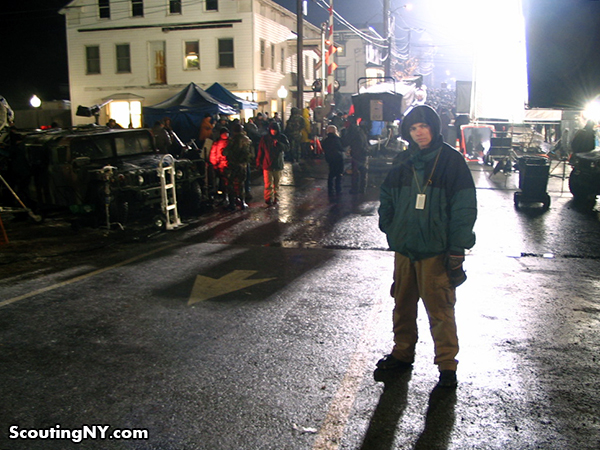 |
| Me attempting a cooler pose after the embarrassing hardhat photograph. |
Essentially, Tom Cruise had a stipulation in his contract that guaranteed him four hard internet lines and four hard phones lines in his trailer at every one of the dozens of shooting locations we were scheduled to visit up and down the East Coast, from upstate New York to West Virginia. I was to be solely responsible for making this happen, from logistics to installation to support.
I had no idea what I was doing.
Pictured above is the “Wireless Internet Trailer,” an enormous satellite dish on wheels some guy had built to miraculously provide internet anywhere you wanted it. As I heard frequently on set, this was to be the future of portable internet access.
It was designed to be idiot-proof. The teamsters would off-load it next to Tom’s camper. I’d then push the button, the dish would rise up, circle around until it got a signal, four lights would blink on, and we had internet. I’d run the hard lines to Tom’s trailer, then start planning the next location.
Except it never, ever worked. I would go on to spend many a freezing morning that winter huddling up in the cold as I waited for a fourth connect light that would never turn on.
Though I was extremely grateful to finally be working on a film set, I was a bit disappointed to have wound up in Locations. All day, I’d watch other departments doing what seemed like very important tasks on set: camera guys changing lenses and pulling focus, grips throwing up stands at a moments notice, electricians running cable, sound guys holding booms, ADs barking orders…
As for locations guys? As far as I could tell, all they did was stand around with a stack of permits not doing much of anything.
One day early on, I mentioned to one of my locations co-workers that I was hoping to get into the camera department on my next job, saying that I thought it would help me to get a better of understanding of how movies were made. He looked at me like I had two heads.
“What do you have left to do today, Nick?” he asked.
“Not much, really,” I said. “The trailer is already hooked up. I need to call Verizon to double-check a few installations, but I’m mainly just standing by in case any of the lines go down.”
“OK. So. Go learn how movies get made.”
It took me a few seconds to understand what he was saying… but the moment I did is the moment I realized I’d found exactly the job I’d been looking for.
The secret beauty of Locations is that the vast majority of our work is done in advance. From scouting and permitting, to contracts and payments, to securing camera positions and parking and dealing with community boards and finding catering spaces – nearly everything is taken care of in prep, which means that on the day of the shoot, as everyone else is scrambling like crazy to get that first scene, you get to simply stand there and watch.
And that is exactly what I did.
Every day, for the rest of the shoot, I’d go out of my way to get my work done early, then hurry over to set to watch Spielberg and company at work. Observing from the sidelines at a respectful distance, I paid close attention to how each camera position and lighting set-up was chosen…
… how actors were blocked, stunts staged, and locations dressed…
It was like going to a film school taught by the best of the best – and I was getting paid to be there. Film crew people will tell you that nothing will ever compare to your first job; for me, War of the Worlds was magical.
After the movie ended, I eagerly signed on to my next film as a Locations production assistant – essentially, the lowest position in the department. It’s probably one of the least glamorous jobs on set, and a typical day will have you hauling trash, plunging toilets, and putting up road signs for crew parking.
But as long as you did your work, you could use your downtime to do as you wanted. For me, that meant going to set and being a fly on the wall as I watched movie after movie get made first hand.
As I worked my way up the locations ladder, I began to devote much of my free time to screenwriting. My goal had always been to direct my own feature, and while I didn’t have a dime to put toward such an endeavor, my friend Jack would always remind me that writing costs nothing. So I kept at it.
—–
I’ve been watching movies get made from the sidelines for quite a while now. And I think it’s finally time to put it all on the line.
Last year, my latest script started getting an extremely positive response, earning the attention of a manager. It quickly became apparent that if I want to make a serious attempt at this, I need to be in Los Angeles.
I didn’t want to leave. I owe everything to New York City. My wife and I have spent ten years building our lives here. Our families, friends, jobs – pretty much everything we know is centered in and around New York. And to give it all up for something as crazy as trying to become director/screenwriter? It would have been so easy, so comfortable, so safe to stay, to just keep doing what we’d been doing for another decade, and another decade after that. The idea of leaping head first into the unknown felt…
… well, it felt a lot like that first day on set.
Which is why I’m going for it.
Thank you to everyone out there for supporting my work over the past seven years, and for coming along on this adventure with me. I hope I’ve made the greatest city in the world seem just a little bit more magical.
-SCOUT
Wednesday, 13 January 2016
Book review: "On Directing Film"
 The book, On Directing Film
The book, On Directing FilmIt is ostensibly about directing, but it’s really about telling stories with pictures. This is a thing that most screenwriters have almost no idea how to do. Most screenwriters write radio plays, not screenplays. This is a visual medium. Learn to use the pictures.
It's a small book, just over 100 pages in paperback. The focus is on the weakness of most wannabe screenwriters—how to tell stories with pictures.
Here are a few quotes from the book:
Here are a few quotes from the book:
A good writer gets better only by learning to cut, to remove the ornamental, the descriptive, the narrative, and especially the deeply felt and meaningful. What remains? The story remains. What is the story? The story is the essential progression of incidents that occur to the hero in pursuit of his one goal.
The point, as Aristotle told us, is what happens to the hero... not what happens to the writer.
 |
| House of Games (1987) |
Screenwriting is a craft based on logic, It consists of the assiduous application of several very basic questions: What does the hero want? What hinders him from getting it? What happens if he does not get it?
We don't have to worry about creating a problem. We make a better movie if we worry about restoring order. Because if we worry about creating problems, our protagonist is going to do things that are interesting. We don't want him to do that. We want him to do things that are logical.
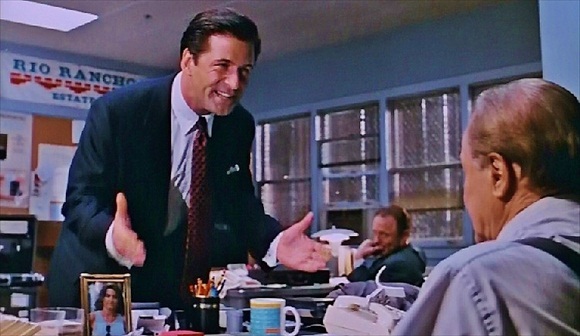 |
| Glengarry Glen Ross (1992) |
If you listen to the way people tell stories, you will hear that they tell them cinematically. They jump from one thing to the next, and the story is moved along by the juxtaposition of images—which is to say, by the cut.
People say, "I'm standing on the corner. It's a foggy day. A bunch of people are running around crazy. Might have been the full moon. All of a sudden, a car comes up and the guy next to me says..."
If you think about it, that's a shot list: (1) a guy standing on the corner; (2) shot of fog; (3) a full moon shining above; (4) a man says, "I think people get whacky this time of year"; (5) a car approaching.
This is good filmmaking, to juxtapose images. Now you're following the story. What, you wonder, is going to happen next.
 |
| State and Main (2000) |
The work of the director is the work of constructing the shot list from the script. The work on the set is nothing. All you have to do on the set is stay awake, follow your plans, help the actors be simple, and keep your sense of humor. The film is directed in the making of the shot list. The work on the set is simply to record what has been chosen to be recorded. It is the plan that makes the movie.
We can identify with the pursuit of a goal. It's much easier to identify with that than with "character traits."
 |
| Wag the Dog (1997) |
Always do things the least interesting way, and you will make a better movie. This is my experience. Always do things the least interesting way, the most blunt way. Because then you will not stand the risk of falling afoul of the objective in the scene by being interesting, which will always bore the audience, who are collectively much smarter than you and me and have already gotten up to the punch line. How do we keep their attention? Certainly not by giving them more information but, on the contrary, by withholding information—by withholding all information except that information the absence of which would make the progress of the story incomprehensible.
 |
| Heist (2001) |
You tell the story. Don't let the protagonist tell the story. You tell the story; you direct it. We don't have to follow the protagonist around. We don't have to establish his "character." We don't need to have anybody's "back story."
If you are telling a story, then the human mind, as it's working along with you, is perceiving your thrust, both consciously and, more importantly, subconsciously. The audience members are going to go along with that story and will require neither inducement, in the form of visual extravagance, nor explanation, in the form of narration.
They want to see what's happening next. Is the guy going to get killed? Is the girl going to kiss him? Will they find the money buried in the old gold mine?
When the film is correctly designed, the subconscious and conscious are in alignment, and we need to hear what happens next. The audience is ordering the events just as the author did, so we are in touch with both his conscious and his unconscious mind. We have become involved in the story.
On Directing Film is practical, provocative, cheap to buy, easy to read. Don't miss it.
is practical, provocative, cheap to buy, easy to read. Don't miss it.
First posted: 28 April 2012
Tuesday, 12 January 2016
Quentin Tarantino’s Visual References
It is a well known fact that Quentin Tarantino is a self-proclaimed cinephile. But the writer/director's love for cinema is most obviously expressed through his own films. In addition to showing his characters spending a great deal of time discussing cinema, Tarantino's films are jam-packed with homages and visual references to the movies that have intrigued him throughout his life.
Many filmmakers pay homage, but Tarantino takes things a step further by replicating exact moments from a variety of genres and smashing them together to create his own distinct vision. Just like Kill Bill: Vol 2 (2004) draws on The Good, the Bad and the Ugly (1966) and Samurai Fiction (1998), Tarantino's work often reflects Spaghetti Westerns and Japanese cinema--both new and old. His unique way of referencing other films allows him to bend genre boundaries and shatter the mold of what we expect to experience. While his methods are often criticized and he is accused of "ripping off" other filmmakers, it seems that Tarantino is simply writing love letters to the art he is ever so passionate about.
From German silent-cinema to American B movies, the following video uses split-screen to demonstrate a few of the hundreds of visual film references over the course of Tarantino's career. ~Jacob T. Swinney
Many filmmakers pay homage, but Tarantino takes things a step further by replicating exact moments from a variety of genres and smashing them together to create his own distinct vision. Just like Kill Bill: Vol 2 (2004) draws on The Good, the Bad and the Ugly (1966) and Samurai Fiction (1998), Tarantino's work often reflects Spaghetti Westerns and Japanese cinema--both new and old. His unique way of referencing other films allows him to bend genre boundaries and shatter the mold of what we expect to experience. While his methods are often criticized and he is accused of "ripping off" other filmmakers, it seems that Tarantino is simply writing love letters to the art he is ever so passionate about.
From German silent-cinema to American B movies, the following video uses split-screen to demonstrate a few of the hundreds of visual film references over the course of Tarantino's career. ~Jacob T. Swinney
Monday, 11 January 2016
The Coen Brothers: POV Shots
With a filmography that covers everything from westerns and gangster flicks to comedies and film noir, it can be rather difficult to pinpoint what exactly contributes to the style of Joel and Ethan Coen. While there are reoccurring themes and ideas that surface throughout the filmmakers' work, a consistent visual aesthetic is not easily recognized. What makes a Coen Brothers film look like a Coen Brothers film? One stylistic element that seems to be rather prominent in all their films is the POV shot. The Coens tend to utilize the POV shot to better submerse us in a scene, but the shot is often used to simply give us a unique perspective that can only be created through cinema. Here is a look at the Coens' use of the POV shot throughout their career. ~Jacob T. Swinney
Sunday, 10 January 2016
'Floating Symbol' Opening Shots
It started with La Dolce Vita (1960). The opening shot is of a statue of Jesus being flown by helicopter over Rome. A second chopper follows, with Marcello Mastroianni as a news reporter aboard. They pass over a luxury penthouse with a group of bikini-clad young ladies, who hold a brief conversation with the chopper pilot.
The next film to employ the floating symbol opening shot was called $ (1971). That was it's original title, which confused people, so for a time it was called Dollars, which wasn't much better, so it became The Heist, one of maybe fifty movies which have employed that phrase as a title. In this film the symbol is an American dollar sign, suspended from a crane over the city of Hamburg.
Rain Man (1988) opens with a red Lamborghini suspended from a crane, as it is unloaded from a ship.
L.A. Story (1991) opens with a hotdog suspended from a helicoptor floating over Los Angeles and being greeted by a group of young women in bikinis.
The next film to employ the floating symbol opening shot was called $ (1971). That was it's original title, which confused people, so for a time it was called Dollars, which wasn't much better, so it became The Heist, one of maybe fifty movies which have employed that phrase as a title. In this film the symbol is an American dollar sign, suspended from a crane over the city of Hamburg.
Rain Man (1988) opens with a red Lamborghini suspended from a crane, as it is unloaded from a ship.
L.A. Story (1991) opens with a hotdog suspended from a helicoptor floating over Los Angeles and being greeted by a group of young women in bikinis.
Saturday, 9 January 2016
Storyteller - Martin Scorsese - A Personal Journey Through American Movies
This is Part 3 of Martin Scorsese's Personal Journey Through American Movies.
Movie clips included in this video are as follows:
The Great Train Robbery (1903) - Edward S. Porter
The Musketeers of Pig Alley (1912) - D.W. Griffith
High Sierra (1941) - Raoul Walsh
Colorado Territory (1949) - Raoul Walsh - Western remake of High Sierra.
Movie clips included in this video are as follows:
The Great Train Robbery (1903) - Edward S. Porter
The Musketeers of Pig Alley (1912) - D.W. Griffith
High Sierra (1941) - Raoul Walsh
Colorado Territory (1949) - Raoul Walsh - Western remake of High Sierra.
Friday, 8 January 2016
Thursday, 7 January 2016
Bohemian Rhapsody: Star Wars Edition
Based on Bohemian Rhapsody by Queen and Star Wars, this video mashup was produced by the students and faculty of the Digital Video Program at University of Advancing Technology in Tempe, Arizona, way back in 2013. This just seems to be the right time to look at it again.
Wednesday, 6 January 2016
The Cinematography of True Grit
Take another look at True Grit, with an emphasis on the cinematography.
Tuesday, 5 January 2016
Hitchcock the Villain
Fabrice Mathieu created this mashup using extracts from thirty of Alfred Hitchcock's films, as well as his many appearances and cameos in films and trailers.
Monday, 4 January 2016
What if Ken Burns Directed a 'Star Wars' Galactic Civil War Documentary?
Ken Burns is an American documentary filmmaker who has produced a series of meditations on Americana. His works are archival materials, utilizing period music, footage, photographs, periodicals and ordinary people's correspondence.
This is what we might see if Ken Burns directed a 'Star Wars' Galactic Civil War Documentary.
This is what we might see if Ken Burns directed a 'Star Wars' Galactic Civil War Documentary.
Sunday, 3 January 2016
Top 10 Best Montages of All Time
It’s parts of a whole, it’s flashes of brilliance, it’s fracturing space, time, reality, and narrative for the sake of the abstract. It’s a montage, and here's one version of the top 10 in movie history.
Saturday, 2 January 2016
Director's Dilemma - Martin Scorsese - A Personal Journey Through American Movies
This is Part 2 of Martin Scorsese's Personal Journey Through American Movies.
Movie clips included in this video are as follows:
The Bad and the Beautiful (1952) - Vincente Minnelli
Duel in the Sun (1946) - King Vidor
It's a Great Feeling (1949) - David Butler - Scene with cameo by King Vidor
The Crowd (1928) - King Vidor
MGM Studio Tour (1925)
Production Footage: The Charge of the Light Brigade (1936) - Michael Curtiz
Production Footage: Lust for Life (1956) - Vincente Minnelli
Movie clips included in this video are as follows:
The Bad and the Beautiful (1952) - Vincente Minnelli
Duel in the Sun (1946) - King Vidor
It's a Great Feeling (1949) - David Butler - Scene with cameo by King Vidor
The Crowd (1928) - King Vidor
MGM Studio Tour (1925)
Production Footage: The Charge of the Light Brigade (1936) - Michael Curtiz
Production Footage: Lust for Life (1956) - Vincente Minnelli
Friday, 1 January 2016
A Supercut of Classics and Guilty Pleasures
You should recognise most of these...
There is a list of titles available as subtitles. (Click CC.) Note: The one labelled Donnie Darko should read Donnie Brasco.
There is a list of titles available as subtitles. (Click CC.) Note: The one labelled Donnie Darko should read Donnie Brasco.



